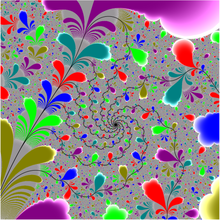Fractals/exponential
In the theory of dynamical systems, the exponential map can be used as the evolution function of the discrete nonlinear dynamical system.[1]

Family edit
The family of exponential functions is called the exponential family.
Forms edit
There are many forms of these maps,[2] many of which are equivalent under a coordinate transformation. For example two of the most common ones are:
The second one can be mapped to the first using the fact that , so is the same under the transformation . The only difference is that, due to multi-valued properties of exponentiation, there may be a few select cases that can only be found in one version. Similar arguments can be made for many other formulas.
How to compute it edit
What is the continous iteration of ? edit
"The function
is one of the simpler applications of continuous iteration. The reason why is because regular iteration requires a fixed point in order to work, and this function has a very simple fixed point, namely zero: "[3]
Images edit
See also edit
References edit
- ↑ Dynamics of exponential maps by Lasse Rempe
- ↑ "Bifurcation Loci of Exponential Maps and Quadratic Polynomials: Local Connectivity, Triviality of Fibers, and Density of Hyperbolicity", Lasse Rempe, Dierk Schleicher
- ↑ Tetration FAQ by Henryk Trappman Andrew Robbins July 10, 2008
- ↑ THE EXPONENTIAL MAP IS CHAOTIC: AN INVITATION TO TRANSCENDENTAL DYNAMICS by ZHAIMING SHEN AND LASSE REMPE-GILLEN
- ↑ Dynamics of exponential maps by Lasse Rempe
- ↑ wikipedia : Exponential map (discrete dynamical systems)
- ↑ Paper by N Fagella
- ↑ Paul Bourke fractals tetration
- ↑ On the Stability of Julia Sets of Functions having Baker Domains by Arnd Lauber ( 2004)
- ↑ Approximation of Baker domains and convergence of Julia sets by Tania Garfias-Macedo aus Mexiko Stadt, Mexiko





